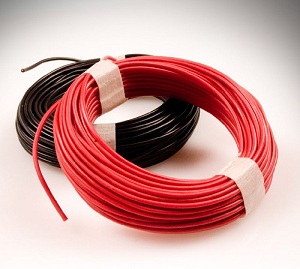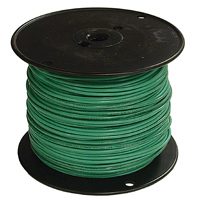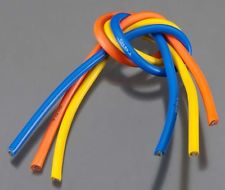Electrical wires are color coded according to an international standard which ensures that engineers and electricians can always quickly and easily identify the intended function of each wire in a circuit. Without this color coding it would be all too easy to make a mistake when changing a plug or re-wiring a circuit, and those mistakes could damage the electrical device, or potentially cause serious harm to the device’s user. Here is a quick overview of the colors used in electrical wiring, and what each color means.

Black

Black wires should be considered “live”. Black represents power and it is never used for a neutral or ground wire. Black wires are often used to connect switches to their electrical supply.
Red
Red wires are also used as live wires, primarily in 220 volt circuits. Red wires can be connected to other red wires and to black wires.
Green

Unlike black wires and red wires, green wires are not live. Green represents the grounding of the circuit. Green wires should never connect to any other color of wire, but they can be connected to another green wire or to the grounding terminal of the outlet box. The green wire’s purpos is to offer a path to ground for the electric current in a circuit. If something goes wrong and a life wire in a circuit happens to come into contact with an external conductor then the current will flow to the green wire and then to “ground”.
White and Gray
White and gray wires are neutral wires. Typically, white is used to represent neutral, but some circuits do use gray. Neutral wires connect to the neutral bus bar – a bar of conductive metal that is designed to attract electric current and send it to feeders. A neutral wire can only be connected to other neutral wires.
Blue and Yellow
 Blue and yellow wires are live wires that are designed to carry power, but are not used for typical plug-in devices. Blue and yellow wires are only found in devices which pull power through conduit, such as fans, switched outlets and structural lights. In most cases, blue wires are used as travellers for multi-way switches.
Blue and yellow wires are live wires that are designed to carry power, but are not used for typical plug-in devices. Blue and yellow wires are only found in devices which pull power through conduit, such as fans, switched outlets and structural lights. In most cases, blue wires are used as travellers for multi-way switches.
There are some colors of wire, and in household appliances it is common to see striped wires. The stripes are used to help people who are color blind identify the wires in question. Some colors, such as brown, are rarely used because they are hard to identify, especially in poor light. Electrical current can be incredibly dangerous so the standards are designed to ensure that the color coding is as simple as possible, and that errors will be incredibly rare.
If you are unsure about the safety of wiring in your home or in an appliance, do not take any chances. An expert electrician in London can perform tests on the circuit to make sure that it is safe and that the wiring is indeed standards compliant. It is better to have such tests carried out than to use an appliance that is wired up incorrectly.











